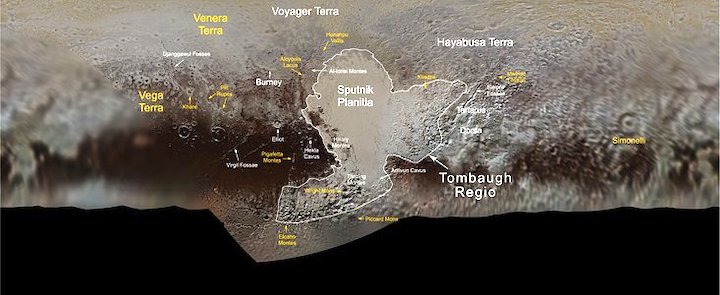11.08.2019

Several people and missions who paved the way for the historic exploration of Pluto and the Kuiper Belt — the farthest worlds ever explored — are honoured in the second set of official Pluto feature names approved by the International Astronomical Union (IAU), the international authority for naming celestial bodies and their surface features.
The new names were proposed by NASA’s New Horizons team, which carried out the first reconnaissance of Pluto and its moons with the New Horizons spacecraft in 2015. Along with a shortlist of official names the IAU had already approved, the mission science team had been using these and other place names informally to describe the many regions, mountain ranges, plains, valleys and craters discovered during the first close-up look at Pluto’s surface. The names have been approved by the IAU Working Group for Planetary System Nomenclature (WGPSN).
The IAU approved the first set of 14 feature names for Pluto in 2017, as well as a set of names for Pluto’s largest moon, Charon, in 2018. The team gathered many of the naming ideas from an online campaign in 2015.
The 14 newest Pluto feature names are listed alphabetically below. The names pay homage to underworld mythology, pioneering space missions that led to the capability to conduct New Horizons, historic pioneers who crossed new horizons in the exploration of Earth, and scientists and engineers associated with the study and exploration of Pluto and the Kuiper Belt.
Alcyonia Lacus a possible frozen nitrogen lake on Pluto’s surface, is named for the bottomless lake in the vicinity of Lerna, a region of Greece known for springs and swamps; the Alcyonian lake was one of the entrances to the underworld in Greek mythology.
Elcano Montes is a mountain range honouring Juan Sebastián Elcano (1476–1526), the Spanish explorer who in 1522 completed the first circumnavigation of the Earth (a voyage begun by Magellan).
Hunahpu Valles is a system of canyons named for Hun Hunahpu, one of the Hero Twins in Mayan mythology, who defeated the lords of the underworld in a ball game.
Kiladze crater honours Rolan Kiladze (1931–2010), the Georgian (Caucasus) astronomer who made pioneering early investigations of the dynamics, astrometry and photometry of Pluto.
Khare crater honours planetary scientist Bishun Khare (1933–2013), an expert in the chemistry of planetary atmospheres who did laboratory work leading to several seminal papers on tholins, the organic molecules that likely account for the darkest and reddest regions on Pluto.
Lowell Regio is a large region honouring Percival Lowell (1855–1916), the American astronomer who founded Lowell Observatory and organised a systematic search for a planet beyond Neptune.
Mwindo Fossae is a network of long, narrow depressions named for the Nyanga (Eastern Dem. Rep. Congo/Zaire) epic hero Mwindo who travelled to the underworld and after returning home became a wise and powerful king.
Piccard Mons is a mountain and suspected cryovolcano that honours Auguste Piccard (1884–1962), a 20th-century inventor and physicist best known for his pioneering balloon flights into Earth’s upper atmosphere.
Pigafetta Montes honours Antonio Pigafetta (c. 1491–c. 1531), the Italian scholar and explorer who chronicled the discoveries made during the first circumnavigation of the Earth aboard Magellan’s ships.
Piri Rupes is a long cliff honouring Ahmed Muhiddin Piri (c. 1470–1553), also known as Piri Reis, an Ottoman navigator and cartographer who drew some of the earliest existing maps of North and Central America.
Simonelli crater honours the planetary astronomer Damon Simonelli (1959–2004), whose wide-ranging research included the shapes of small satellites and the formation of Pluto.
Vega Terra is named for Vega 1 and 2, the first spacecraft to fly balloons on another planet (Venus) and to image the nucleus of a comet (1P/Halley).
Venera Terra is a large landmass named for the Venera missions sent to Venus by the Soviet Union from 1961 until 1984; they included the first human-made device to enter the atmosphere of another planet, to make a soft landing on another planet and to return images from another planetary surface.
Wright Mons honours the Wright brothers, Orville (1871–1948) and Wilbur (1867–1912), the American aviation pioneers credited with building and flying the world’s first successful airplane.
The New Horizons spacecraft — built and operated at the Johns Hopkins Applied Physics Laboratory in Laurel, Maryland, with a payload and science investigation led by Southwest Research Institute — is nearly 6.6 billion kilometres from Earth. The spacecraft is in good health and transmitting data recorded during its New Year's 2019 encounter with the Kuiper Belt object 2014 MU69 — nicknamed Ultima Thule — the most distant and most primitive object ever explored.
More information
The IAU is the international astronomical organisation that brings together more than 13 500 professional astronomers from more than 100 countries worldwide. Its mission is to promote and safeguard astronomy in all its aspects, including research, communication, education and development, through international cooperation. The IAU also serves as the internationally recognised authority for assigning designations to celestial bodies and the surface features on them. Founded in 1919, the IAU is the world's largest professional body for astronomers.
Quelle: IAU
